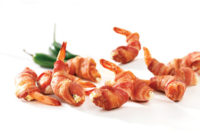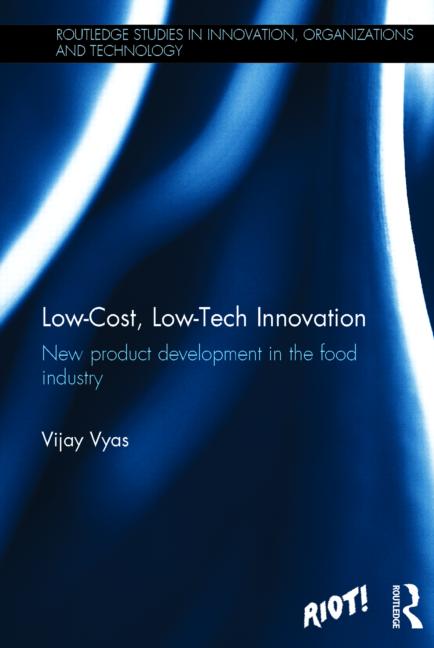SPIRIT OF INNOVATION AWARDS | 2006 RETAIL WINNERS
Awarding Innovation "Naan" Too Soon

FGF Brands' stated product goal would seem a simple enough concept: “to develop and bring to market a line of authentic, all-natural ethnic flatbreads to celebrate this universal eating experience.” Operating from the premise that every culture in the world enjoys some form of tasty flatbread, FGF developers set about creating a commercialized version of such a product, sensing that Americans are looking for something authentically ethnic and capitalizing on the fact that flatbreads can be consumed for any day part--breakfast, lunch or dinner. A number of recipes were in development and, from the outset, FGF said its launch product would be whichever flatbread was first perfectly duplicated.
Early contenders for the launch bread included a Persian seed bread that the development team discovered in Asian travels, as well as a Genovese focaccia and an Armenian lavosh, also spotted on different travels. In the end, FGF opted to produce an authentic naan as its first commercial flatbread. Naan, a Hindustani term actually meaning “bread,” is of Indian origin, though forms of the bread can be found throughout South and Central Asia.
Deciding upon the product would not be the most challenging aspect of FGF's new creation, however. Like most Asian flatbreads, naan must be baked in a special, blisteringly hot oven called a tandoor, whose temperatures can exceed 1,500°F. Realizing such an oven would be essential to the authenticity of the naan, FGF developers then faced the daunting task of creating a tandoor that could handle the capacity expected of a major product launch across North America.
At the time, only Indian restaurants had the capability of operating small-scale tandoor ovens, and these were only for making one or two naan at a time. FGF would be the first to scale up the concept and commercialize the process. Enter the first of a number of teams that would be instrumental in the country's first commercial naan.

Team Players
The first team had the unenviable duty of designing, blueprinting and building the world's first commercial, continuous tandoor oven. Sam Ajmera, chairman of FGF Brands and co-founder of Canada's Dough Delight bakeries, would bring in Jack Gordon as chief project engineer. Gordon, a bakery engineer responsible for constructing seven bakeries for Dough Delight, hired a group of six capable food scientists and engineers to fulfill an ambitious mission: designing and building the world's first continuous, commercial tandoor oven and have it producing fully baked, authentic naan within one year. In addition, there were, of course, financial aspects to consider. The blueprinting, engineering and construction costs of the tandoor oven and all associated fees (salaries, equipment, shrinkage, etc.) had to come in within budget, and they did. How innovative is the continuous commercial tandoor oven? FGF has an international patent pending on the equipment.
Gordon was joined in this effort by Tejus Ajmera, Sam's youngest son who runs all the bakery operations at FGF Brands and is responsible for the company's products—muffins, brownies and ethnic flatbreads. The pair worked around the clock to meet their restrictive engineering deadlines.
Right at the start, FGF had a major concern: how to build a sufficiently large tandoor oven inside the firm's already functioning, tightly packed plant. Gordon and Ajmera finally agreed that component parts would have to be built off-site and the whole oven assembled piece by piece amidst the working bakery on off-days or weekends, when muffin and brownie production were non-existent.
Despite time constraints and the demands of running a commercial bakery, Gordon and Ajmera (Tejus) easily scaled the engineering bar and, in the process, set and met another goal for themselves within that same one-year timeframe: they led the company to earn an “excellent” rating from an independent, third-party manufacturing auditor. Silliker Labs scored FGF's operational practices and workplace environment 95 points, considered “excellent,” the auditor's highest industry rating.
At the same time, a second FGF team also was hard at work. In addition to inventing an oven and manufacturing process to produce authentic naan, FGF had to assemble a highly capable product development team to replicate the look, texture and taste of restaurant-quality naan. From the beginning, the company had a number of self-imposed criteria for its naan: its flatbread would have to have the same “sultry, smoky” taste as restaurant naan; it would be all-natural, containing no preservatives, trans-fat or hydrogenated oils. Every naan had to be hand-stretched, and for culinary accuracy, FGF's naan would be made with ghee.
A type of clarified butter found in Indian and Pakistani cuisine, ghee has a distinctive nutty aroma unlike Western clarified butters. Furthermore, it can be stored for extended periods without refrigeration, provided it is kept in an airtight container to prevent oxidation; its extended shelflife results from the destruction of microbes and enzymes during simmering and the removal of water.

Fixing Flats
Simultaneous with the development of the commercial tandoor, FGF had to create a unit to test, identify and duplicate authentic international flatbread recipes in small, test-kitchen batches. Barb Druxerman, a developer behind literally hundreds of products for some of North America's top private-label brands and consultant to some of North America's largest food manufacturers, led the product development unit. She and Hans Grisell, a 40-year veteran of large commercial bakeries, were ultimately responsible for the naan recipe.“There were two elements of making naan that had to be mastered—the baking and the cooling,” says Druxerman. “We knew that we wanted to hand-stretch every one of our naan, just as they do in India, and we knew that we wanted each one to bake in 30 to 40 seconds. We mastered this early on.”
“It took us longer to learn how to efficiently cool our breads. As our naan are shipped frozen (they are thawed at store level), we had to invent a gentle, extended cooling process to allow the flatbreads to lose a calculated amount of moisture slowly before being frozen—so that when thawed, the flatbreads would have an ideal amount of retained moisture to keep them moist and flavorful, giving them a self-imposed, five-day shelflife at ambient temperature. By managing the cooling time, we accomplished this without having to add any preservatives or shelf-extenders to the naan.”
The vision for an entire line of ethnic flatbreads was the brainchild of Sam Ajmera, who has always wanted to bring to market such a line of authentic products. His partner in FGF Brands is Jim White, a lifetime veteran of the food industry and perhaps best known for coining the term “President's Choice” for Loblaws Supermarkets in the mid-1980s and for leading the team that created the initial 1,500 items of what was North America's first line of premium private label products. White has been responsible for the development and marketing of more than 8,000 private label foods and beverages for leading supermarkets in North America. FGF Brands represents the duo's goal of bringing to market a line of healthier-for-you muffins, brownies and ethnic flatbreads, “free of as many chemicals and preservatives as possible,” notes White. FGF represents what they term is a “sort of Ben & Jerry's approach to bakery”: they aim to put wholesome ingredients in their products, with minimal manufacturing intervention, leading to wholesome products coming out to the consumer — all of the products marketed with “flair, fun and underlining the goodness and taste of the finished products.”
White and Ajmera's eldest son, Ojus, spent a year searching out flatbread possibilities and gauging the market's interest in ethnic bread. The pair were responsible for product direction, marketing and sales of the company's ethnic flatbreads. To add breadth to their team, they added two knowledgeable flatbread specialists, Jeffrey Alford and Naomi Duguid, who together wrote such Asian flatbread cookbooks as Flatbreads & Flavors, Mangoes & Curry Leaves and Hot Sour Salty Sweet and who now work exclusively with FGF Brands on the development of ethnic flatbreads.
Finally, but equally important, especially when it came to the ultimate consumer acceptance, was the team behind the packaging of FGF's naan, by this time bearing the retail name Fabulous Flats. The packaging experts, led by the elder Ajmera, identified a customized packaging system and devised a package that would serve to both show off and protect the fully baked naan. Then, the job of creating an attractive naan package design fell to Jenn White, a packaging and label designer based in San Francisco.
“I wanted the naan to be the hero on the grocery shelf, so we opted to use a clear, oxygen-barrier film to wrap the flatbread, not an opaque film with 'suggested usage' photos,” she recalls. “There is an immediacy to bread that needs to be seen and felt; it can't be packaged like cereal or other foods that rely on a photo of a potential table serving.”
The four teams may have worked independently of each other for the most part, but each had strict, overlapping deadlines with no allowance for delay. In the end, all four met their respective goals on time and, within one year of ideation, naan were streaming out of FGF's innovative commercial tandoor oven at the rate of one million a week. Each naan is hand-stretched, all-natural and preservative-free, and supermarket response has been strong.
With no other commercial flatbreads remotely like it, Fabulous Flats hold a unique spot in the marketplace. Whole Foods has launched Fabulous Flats naan in regional U.S. locations, and White reports some conventional supermarket retailers around the country are serving FGF's naan with their home meal replacement dishes. In addition, FGF's naan has begun to make in-roads on the foodservice side: operators have been using the flatbread to make rolled-up, wrap-like sandwiches (FGF has an affinity for the term “naanwiches”), and one chain has even used the products as a base for its thin-crust pizzas.
FGF Brands is no stranger to the Spirit of Innovation Awards. In 2005, the company had a strong showing on the retail side with its line of muffins enhanced with 1,000mg of omega-3 fatty acids and 5mg of fiber (a product which netted the company second place in last year's SOI Awards) and a line of brownies for foodservice, which have since expanded into a variety of upscale coffee houses.
Like last year's winning products, FGF Brands' Fabulous Flats likewise reflect the teamwork, innovation and understanding of consumer needs and wants that are at the heart of the Spirit of Innovation Awards. Furthermore, this innovation at FGF shows no signs of abating. The company says it has 10 more ethnic flatbreads on the drawing board, every one of them to be baked in the commercial tandoor oven and each poised to capitalize on the growing market for ethnic foods. Clearly, this is an innovation that will continue to reap rewards for FGF.
Website Resources:
www.venturafoods.com -- Ventura Foods, co-sponsor of the SOI Awardswww.fgfbrands.com -- FGF brands company website
www.bettycrocker.com/products/prod_warmdelights.aspx -- Betty Crocker's Warm Delights
www.kame.com/whats_new.html -- Ka-Me's Pad Thai

Sidebar: The Warm Form
Recognizing consumer desires is one thing; creating a product that meets their wants--on a multitude of levels--is something else entirely. In developing Warm Delights, developers at General Mills were meeting a number of trends head-on: convenience and indulgence being the primary two. However, doing so would require a cross-functional effort throughout the process, and it would display a degree of teamwork worthy of second-place recognition in the 2006 Spirit of Innovations Awards--Retail.No matter the concerns about health and obesity that are espoused by various trend watchers, indulgence has been, continues to be and will remain of interest to consumers. Granted, these indulgences may have to bow to certain demands, saving time being one of the primary ones. General Mills recognized consumers are seeking high-quality baked goods that are simple and easy to prepare, in many cases a treat “just for me” at the end of the day. Microwave baking can be quick and simple, but it is frequently met with skepticism from consumers.
General Mills' Warm Delights team took those opinions as a challenge and determined to create an “exceptional baked good that delivered on the tagline 'just three minutes from heaven,'” notes David Tobelmann, senior technology manager with General Mills.
From the start, packaging experts had to be involved, as the product had to communicate convenience, a single serving and indulgence. As Tobelmann recalls, “The development approach to Warm Delights was unique due to the very close packaging-product-operations interaction.” The team, comprising R&D working closely with consumer insights, packaging, product design, quality, operations and marketing, defined the requirements at the start and determined the key decision maker for all stages. This enabled them to focus on the end goal, quickly make decisions, and simultaneously provide sufficient autonomy for the team to execute under the project's demands.

Sidebar: Thai One On
Ka-Me is a brand with a long history. For over 30 years, it has offered packaged Asian ingredients and condiments; however, for its newest offering, developers at brand-owner Liberty Richter would look to territory uncharted in the brand's history.In the process, the groups displayed a level of teamwork in creating this innovative new product that would warrant a third-place finish in the 2006 Spirit of Innovation Awards--Retail. The Ka-Me Pad Thai Noodle Box was the brand's first venture into a convenience product for the Asian foods market. Developers had a straightforward goal: create a meal solution built on the brand's heritage of authenticity that would also give the consumer a traditional Asian dish in just two minutes.
An internal team from marketing, graphics, operations, sales and finance would complement a manufacturer able to meet a number of goals:
* A noodle that required no water for cooking
* A retort pouch to protect premium sauce ingredients
* The use of authentic Asian ingredients
A production facility outside of Bangkok met all the criteria and, in addition, facilitated communications between the packaging printer and the graphics group. The graphics department worked with the existing “take-out”-shaped box, which serves to give the product a more upscale appearance. The result is the most successful product the brand has ever launched. Since its debut, additional SKUs have been added, bringing the total to nine meals with either noodles or rice and a sauce pouch. As Martin Salerno, senior product manager with Liberty Richter, notes, “The Pad Thai Noodle Box project succeeded because of the expertise and teamwork of each group.”
Looking for a reprint of this article?
From high-res PDFs to custom plaques, order your copy today!







